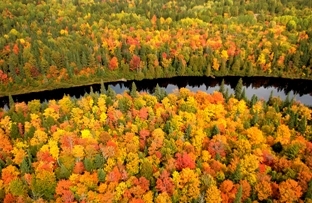|
April 20, 2017
Contact: Ed Golder, 517-284-5815
Michigan’s public lands are Earth Day’s unsung heroes
Pollution prevention, water filtration among the natural benefits
 Want to celebrate an Earth Day hero? Look no further than the nearest parcel of state-managed public land in any corner of Michigan. Want to celebrate an Earth Day hero? Look no further than the nearest parcel of state-managed public land in any corner of Michigan.
As the April 22 Earth Day observance approaches, it’s a good time to appreciate our state-managed public lands for all they do to enhance quality of life in Michigan. The Department of Natural Resources manages 4.6 million acres of land for the public’s use and enjoyment, including state forests, game areas, recreation areas and parks. Aside from the high-value cultural, recreational and economic opportunities they provide, Michigan’s public lands have enormous impact on the quality of our environment and natural resources.
The lands reduce air pollution, protect water quality, provide flood retention and offer critical wildlife habitat. Like true heroes, they do their jobs without fanfare.
“People usually associate public lands with outdoor adventures such as camping, hiking or hunting,” said DNR Director Keith Creagh. “But they may not realize the tremendous natural benefits these spaces provide. Their contributions to the health of Michigan’s environment, natural resources and citizens are many. That’s why proper management of these valued public lands is so critical.”
Ways in which public lands improve our environment, natural resources and even public health include:
-
Pollution prevention. Forests and wetlands on public lands benefit the environment by serving as natural “purifiers.” For example, trees help reduce air pollution by absorbing pollutants and increasing oxygen levels in the atmosphere. Wetlands play a vital role by filtering pollutants from surface runoff, and breaking down fertilizers, pesticides and other contaminants into less harmful substances.
-
Improved water quality. Tree roots hold soil together and soak up moisture, which enhances water quality and prevents erosion. In addition to filtering pollutants, wetlands improve water quality by recharging groundwater supplies when connected to underground aquifers. They also contribute to natural nutrient and water cycles.
-
Storm water management. In natural landscapes like forests, the soil absorbs water and pollutants resulting from runoff from hard surfaces such as driveways and parking lots. This is especially important in reducing flooding.
-
Wildlife habitat. Fields, forests, waterways and wetlands provide Michigan’s wildlife with the vibrant ecosystems they need to thrive.
-
Better health. Nature plays a huge role in the physical and emotional health of Michiganders. The ability of trees and grasslands to filter air pollution reduces negative health effects on people with respiratory ailments. Plus, state-managed public lands – offering trails, boat launches, campgrounds and other outdoor recreation options – provide any number of opportunities for exercise and fitness. Of course, trees, lakes and rivers offer calming effects that are emotionally gratifying as well.
-
Good stewardship. Michigan’s public lands promote good environmental stewardship. They allow for initiatives such as Michigan’s Wetland Wonders, which provide exceptional waterfowl hunting opportunities through the world-class management of the state’s seven premier Managed Waterfowl Hunt Areas. The DNR also is pursuing an innovative wetland mitigation program that harnesses public lands to help offset the loss of wetlands.
“We’re a cleaner, healthier Michigan because of our public lands,” Creagh said. “So much of what they do for us happens without notice. But Earth Day provides a good opportunity to appreciate all our state-managed public lands do for the citizens of Michigan.”
/Note to editors: Accompanying photos are available below for download. Suggested caption information follows.
Tahquamenon River fall forest: An aerial view of the Tahquamenon River and the surrounding fall forest, a popular tourist destination in the eastern end of Michigan’s Upper Peninsula.
Maple River SGA: Maple River State Game Area, covering more than 9,200 acres in Clinton, Gratiot and Ionia counties, offers residents and visitors access to wildlife viewing, hunting and other outdoor exploration. It provides substantial acreage for pheasant and other wildlife habitat./
The Michigan Department of Natural Resources is committed to the conservation, protection, management, use and enjoyment of the state’s natural and cultural resources for current and future generations. For more information, go to www.michigan.gov/dnr.
|

 Want to celebrate an Earth Day hero? Look no further than the nearest parcel of
Want to celebrate an Earth Day hero? Look no further than the nearest parcel of 




